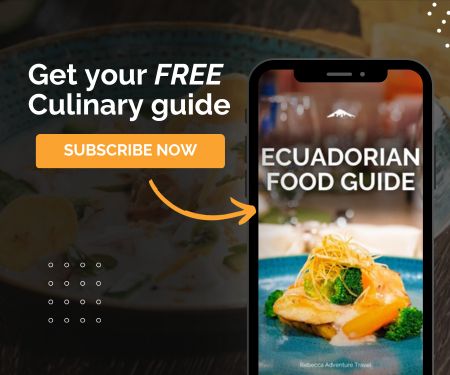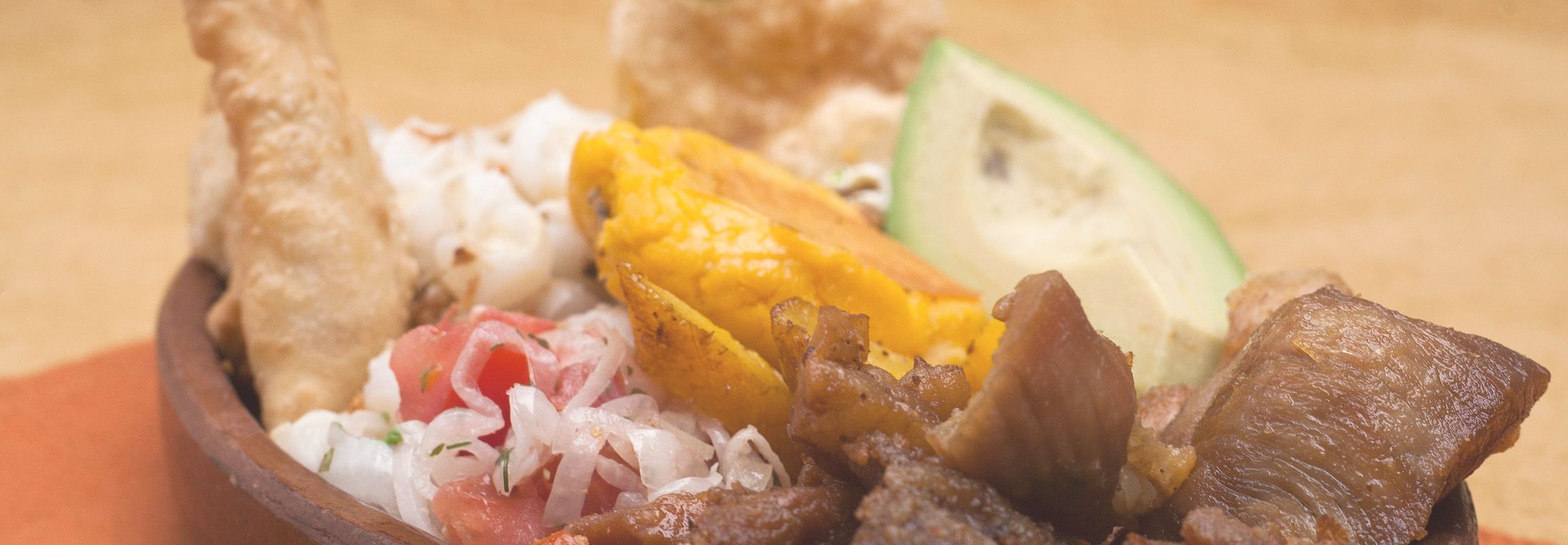
What to Eat in Ecuador – Comprehensive Culinary Guide
If you’re wondering what to eat in Ecuador during your travels, let our comprehensive culinary guide introduce you to all the savory dishes and recipes that Ecuadorians love. The cuisine in South America is as diverse as it is delicious, with each region and country showcasing their most nutritious and flavorful ingredients in every recipe. Corn, potatoes, pork, plantains, shrimp, and a myriad of fruits and vegetables come together in the most colorful and tasteful dishes. While similarities can be found throughout the Latin American world with dishes that share basic ingredients, each country offers a unique interpretation in their preparations, resulting in the most distinctive and tantalizing culinary experiences. Ecuador is no exception, boasting a variety of delectable flavors across its four regions: Costa, Sierra, Amazonia, and Galapagos. Explore the finest dishes of Ecuador through this comprehensive Ecuadorian Food Guide.
Allow us to introduce you to one of Ecuador’s best kept secrets: Ecuadorian cuisine.
Distinct Flavors of Every Region
The Ecuadorian Coast
With its splendid beaches and charming ports along the Pacific Ocean, the Ecuadorian coast is home to some of Ecuador’s most beloved and renowned dishes. While each province offers its unique variations, seafood consistently takes the center stage. Combined with coconut, peanuts, green and ripe plantains, and local spices, visitors are in for a delectable treat. Notable recommendations include Encebollado (a soup with white tuna), Cazuela de Mariscos (a casserole with green plantains and seafood), Encocado (shrimp or fish in a coconut sauce), Tigrillo (crushed green plantain with pork or cheese), Ceviche de Camaron (shrimp ceviche), and Arroz Marinero (rice with seafood). Many other traditional coastal dishes await to delight you at every corner.

Tigrillo from the Province of El Oro, Coast
The Andes
Moving eastward from the Coast toward the center of the country and ascending a few thousand meters above sea level, you’ll reach the Sierra or Andes region. Snow-capped mountains, rocky peaks, picturesque Andean communities, and a tapestry of crop fields paint this colorful and fascinating region. Here, various types of animal protein such as pork and veal, grains such as corn, broad beans, black beans, and, and tubercules like yams and potatoes are the stars of the Ecuadorian Andean recipes. Some of our favorite recommendations include Locro de Papa (potato soup), Fritada (fried pork), Hornado (baked pork), Llapingachos (potato patties), Tamal Lojano (corn tamale), Fanesca (andean grains soup), and cuy (guinea pig). Other savory recipes make up the Andean menu. Make sure to try them all!
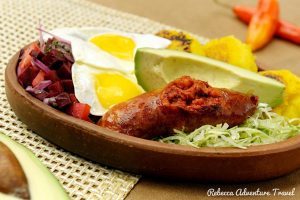
Llapingacho from the Province of Tungurahua, Andes
The Amazon Jungle
Venturing eastward beyond the Andes mountains, the lush Amazon jungle beckons to be explored, bringing with it a gastronomy that surprises the senses with its exotic ingredients and unique cooking techniques. Amazonian cuisine typically blends freshwater fish, herbs, Amazonian fruits, yams, and green plantains. Some recipes even incorporate insects and unconventional meats like turtle, snake, and tapir. Among the Amazonian dishes we recommend trying are Ceviche Volquetero (tuna ceviche with fried green plantains), Ayampaco (baked fish and green plantain wrapped in a plantain leaf), Maito (steamed fish wrapped in a plantain leaf), Chicha (a corn-based drink), and, for the adventurous, Chontacuro—a type of edible worm.

Maito from the Province of Orellana, Amazon
The Galapagos Islands
Finally, spanning hundreds of kilometers across the ocean to the east of Ecuador’s coast, you’ll discover the unique Galapagos Islands. Ingredients in the Galapagos are primarily sourced from the mainland, as the Islands are strictly controlled to preserve their delicate environment. Locally sourced vegetables and fruits, such as plantains, Ecuadorian oranges, and mangos, ensure freshness. The culinary focus is on a variety of regional seafood, including fish, crab, shrimp, lobster, octopus, and oysters. These are often combined with traditional Ecuadorian ingredients to create flavorful dishes.
Although the Galapagos Islands don’t have their own original dishes, locals draw inspiration from traditional Ecuadorian recipes, particularly those from the Coast. Bearing this in mind, it’s clear that ceviche is a standout favorite on the Galapagos Islands. We highly recommend trying the Ceviche de Canchalagua, prepared with a native Galapagos mollusk.
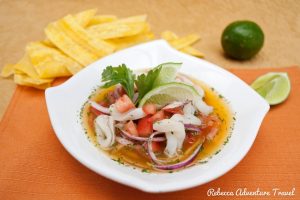
Ceviche de Canchalagua from The Galapagos Islands
Request your free Guide:
Ecuadorian Culinary Delights
Explore Ecuador’s diverse cuisine with our free guide, packed with essential insights and mouthwatering recipes.
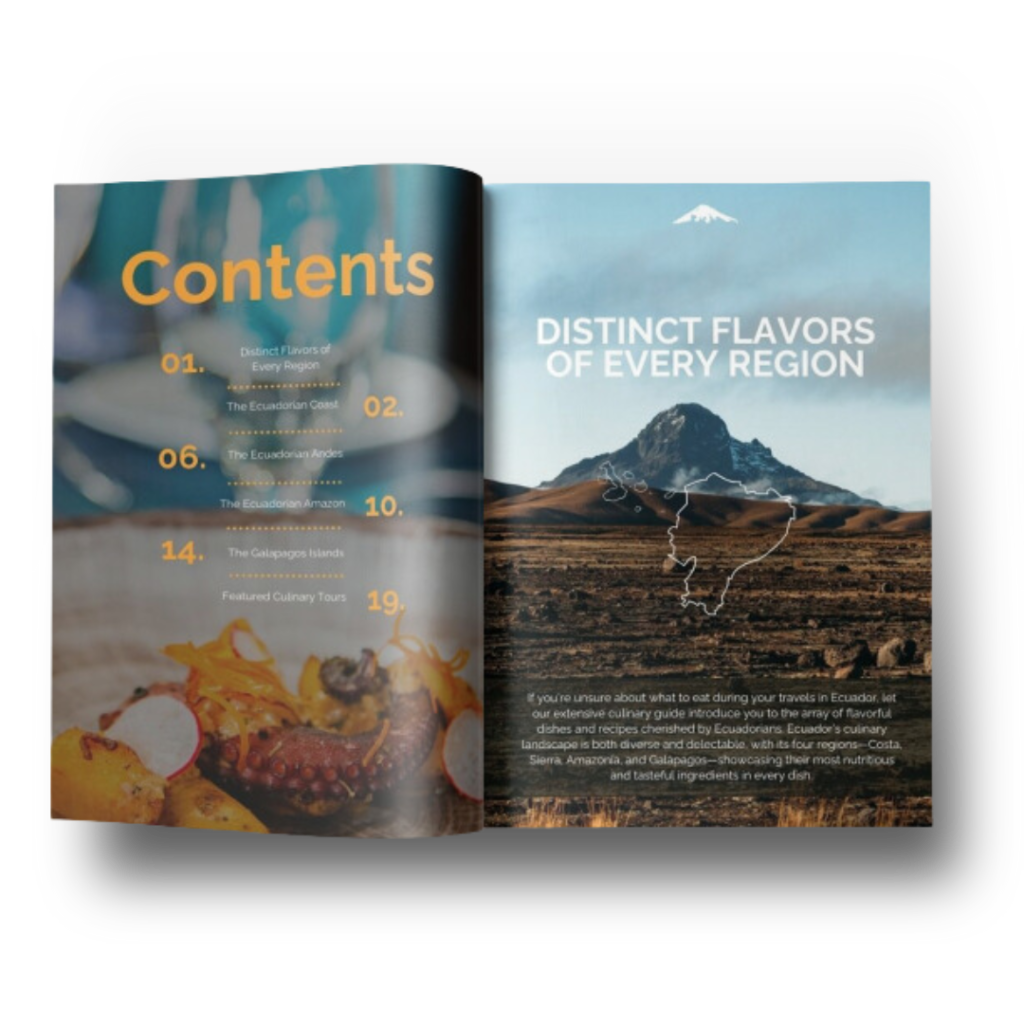
Ecuadorian Gastronomy
Ecuadorian gastronomy is very unique. In Ecuador as a whole, rice is eaten almost daily. The same goes for soups. There are a ton of different delicious soups, most are served hot like Locro, and some are served cold (at room temperature) like Ceviche. Ecuadorian soups usually combine flavors and have become an important part of both, daily lunches, and Ecuadorian cuisine.
Fruits are also an important part of our Ecuadorian Food Guide. Ecuador is full of fruits of all sizes, colors, and tastes. Citric, sweet, sour, and even more than you can imagine. Some examples are naranjilla, guanabana, tamarillo fruit, coco, yellow and white pineapple, maracuya, granadilla, pitahaya, and a handful of varieties of mango. It is also not uncommon to prepare juices with two or more combinations of fruits. Making a combination of juices is like a laboratory experiment!
For example, this may be a fruit you may have not tasted (yet): the Golden Berry or Uvilla.
Ecuadorian Gastronomy
Ecuadorian gastronomy is truly distinctive. Rice and soups are staples in Ecuador, with a wide array of delicious options available. These soups, like Locro and Ceviche, play a significant role in daily meals and the overall cuisine.
Fruits also play a crucial role in Ecuadorian cuisine. Ecuador is blessed with a myriad of fruits of various sizes, colors, and flavors—ranging from citrus to sweet and sour. Local favorites include naranjilla (little orange), guanabana (soursop), tomate de árbol (tamarillo), coco (coconut), yellow and white pineapple, maracuya (passion fruit), granadilla (of the passion fruit family), pitahaya (dragon fruit), and a diverse array of mango varieties. The preparation of juices from combinations of two or more fruits is also common and is usually enjoyed during meals. You can inquire at local supermarkets or traditional markets for uvilla (golden berry) or capuli (black cherry) and be amazed by these new flavors.
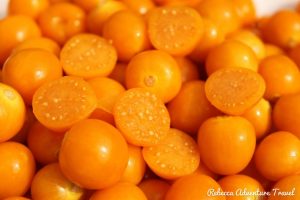
Uvillas (Golden Berries)
Traditionally, notable differences exist between dishes from the Coast and those from the Andean regions, though this doesn’t preclude coastal cuisine in the Sierra or vice versa. Additionally, specific dishes are reserved for certain festivities, like Fanesca—a blend of 12 different grains—traditionally enjoyed during the Pre-Hispanic festivity of Muashuk Nina or ‘New Fire.’ This festivity marked the start of a new Andean Year and is now enjoyed during Holy Week. Colada Morada is another example, prepared exclusively in November for Día de los Difuntos (Souls’ Day or Day of the Dead).
Here’s a Gastronomic Map detailing numerous traditional dishes from each region.
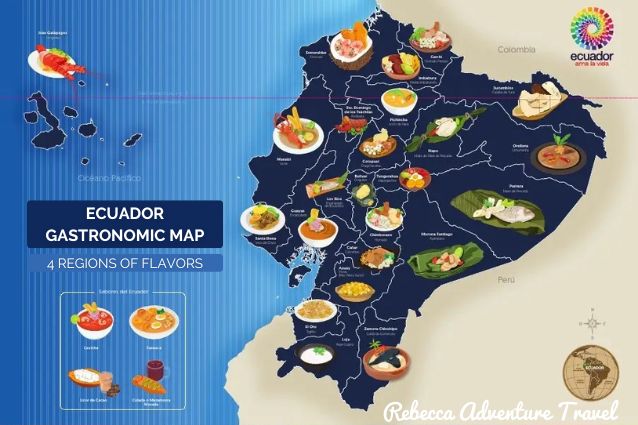
Gastronomic Map
Typical Ecuadorian Food Guide
Main Courses
- Fritada: Small, square-cut pieces of pork cooked in spiced water and then fried in their own fat until they’re golden and crispy. Fritada is commonly served with llapingachos (potato patties), mote (boiled corn), boiled potatoes, corn on the cob, sweet fried plantains, avocado, pickled onions, and tomato.
- Hornado: Pork marinated for three days is then slow-cooked in a wood oven until the meat becomes tender. It’s served with similar accompaniments as Fritada.
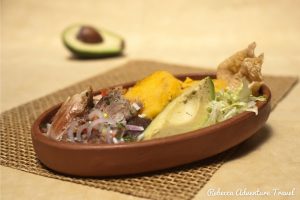
Hornado
- Ceviche: A quintessential seafood dish popular along the coasts of South America, with each country offering its unique variations. Ceviche can be prepared with seafood like shrimp, fish, oysters, octopus, and more. These are marinated in lemon or lime juice, along with chopped onions, tomato, salt, and herbs such as coriander. It’s often served with garnishes like patacones (thick green plantain chips), chifles, or salty popcorn. While typically made with fish, shrimp, or oysters, ceviches can also be mixed seafood varieties.
- Encocado de Camaron: Shrimp, a specialty of Ecuador, is a year-round favorite. Typically seasoned with citrus and spices, shrimp is cooked in a sauce of cilantro, onions, tomatoes, bell peppers, and coconut milk, served with rice.
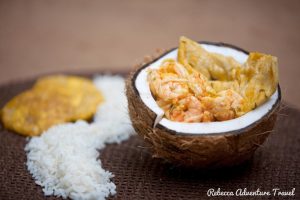
Encocado de Camarón
- Churrasco: A staple of the Coast Region, especially in Guayaquil. Churrasco features grilled steak seasoned with chimichurri and is served with plantains, white rice, French fries, a fried egg, slices of avocado, a salad, and aji.
- Cuy: Guinea pig meat, known for its high protein and low cholesterol and fat content, offers a taste reminiscent of rabbit and chicken. It can be fried, broiled, or roasted, accompanied by potatoes, hominy, salad, and even peanut sauce. Depending on the region and the restaurant, cuy may be served whole or sliced.
- Mote Pillo: Sautéed hominy (mote) blended with onions, garlic, achiote, eggs, milk, chives, and coriander or parsley, resulting in a creamy texture. This dish is particularly popular in Cuenca.
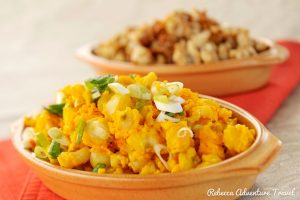
Mote Pillo
- Camarones y Langostinos: Ecuadorian shrimps and prawns, known for their world-class quality and status as a major export, are prepared in various ways, often with avocado or tangerine. These delectable seafood options feature prominently in various dishes, including Ceviche, Encocado, Breaded, and numerous soups and main courses.
- Maito: Maito, akin to Tilapia, is wrapped in baijao leaves along with vegetables and fruits such as palmito and peach palm, then roasted over an open fire and steamed.
Ecuadorian Soups and Stews
- Encebollado: Among Ecuador’s most beloved fish soups, Encebollado is a top recommendation in this Ecuadorian Food Guide. It’s often said that if you don’t like Encebollado, you’re not truly Ecuadorian, given its popularity. Typically served with boiled cassava and pickled red onions, it features a dressing made from fresh tomato and spices like pepper or coriander leaves. While albacore is the common fish used, tuna, billfish, or bonito can also be utilized. Ripe avocado, chifles (plantain chips), plantains, and popcorn often accompany the dish, which can be garnished with lime juice, aji, or ketchup. It’s also a well-known remedy for chuchaqui (hangover) after a night of drinks.
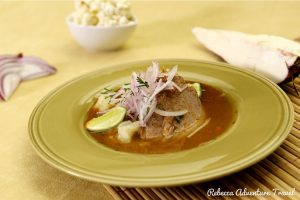
Encebollado
- Locro de Papa con Queso: A creamy potato soup garnished with cheese and avocado, Locro de Papa con Queso is a popular Andean dish. It’s typically made with “papa chola,” a specific type of potato with a unique taste and texture that’s difficult to find beyond its home region. Optional ingredients might include chochos, a type of meat (usually beef), oregano, garlic, achiote, onions, beans, squash, pumpkin, or chard. Another variant, common in the Andes, is Yahuarlocro, named after the Quichua words for “blood” and “soup.” This variant includes clogged and fried lamb or chicken blood. Yahuarlocro is emblematic of Ecuadorian Gastronomy.
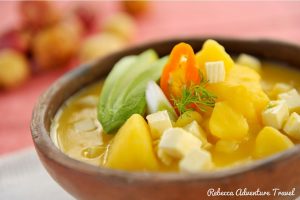
Locro de papa
- Fanesca: A soup deeply rooted in Ecuador’s culinary tradition, Fanesca is typically prepared and enjoyed by households and communities during Holy Week (Semana Santa). Fanesca’s ingredients and preparation method vary significantly from region to region and even from one family to another. It’s typically served exclusively in the week leading up to Easter. This hearty soup comprises figleaf gourd (sambo), pumpkin (zapallo), and twelve diverse types of beans and grains, including lupines (chochos), fava beans (habas), lentils, peas, corn, and others. These ingredients blend with bacalao (salted cod) cooked in milk. Given the Catholic prohibition against red meat during Holy Week, fish is used in lieu of meat. Hard-boiled eggs, fried plantains, herbs, parsley, and empanadas often garnish Fanesca. A plate of this delightful dish is guaranteed to satisfy your appetite.
- Guatita: A stew prepared with cow stomach (tripe), potatoes, peanut sauce, and rice.
- Seco de Pollo and Seco de Chivo: Stews featuring chicken or goat meat, served with rice, plantains, and salad. Goat stew requires meticulous preparation due to specific ingredient requirements, but the result is well worth it.
- Sopa de Bolas de Verde: A soup crafted from plantain dumplings stuffed with meat and vegetables, served in a beef broth with corn and yuca.
- Caldo de Patas: A soup based on cow’s feet and hominy (mote), a boiled grain typical of Ecuadorian cuisine. This soup is typically accompanied by herbs and served steaming hot.
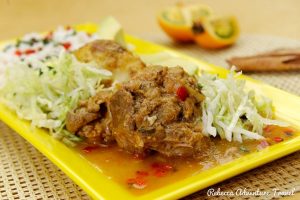
Seco de chivo
Street Food
- Humitas: Originally a Native American dish dating back to pre-Hispanic times, Humitas is a traditional food in several South American countries, including Ecuador. This dish involves slowly steaming or boiling corn in a pot of water. Ecuadorian Humitas are prepared with fresh ground corn, combined with onions, eggs, and region-specific spices. The mixture is wrapped in a corn husk and steamed. In Ecuador, Humitas may also contain cheese. A sweeter variant known as Quimbolitos may include raisins.
- Bolones: Bolones de Verde (Green Plantain Balls) consist of green bananas stuffed with cheese, chorizo, chicharrones, or peanut butter. Mashed green plantain is formed into a dough, its texture varying based on the banana variety, and filled with corresponding cheese, pork, peanut, or combinations of ingredients. The dough is shaped into round balls and fried until crispy. Enjoy them with Aji for the full experience.
- Empanadas: These pastries, baked or fried, are staples in Latin Europe and Latin America. Empanadas are made by folding dough or bread around fillings that encompass a range of options, from meat and cheese to vegetables and fruits. Ecuador features various empanada variants, including Empanadas de Morocho (made from a grain called Morocho), Empanadas de Verde (using green plantains), and Empanadas de Viento (filled with cheese and sugar, inflated for a substantial texture).
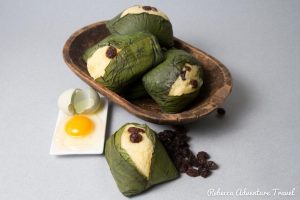
Quimbolitos
- Ceviche de Chochos: A vegetarian ceviche created from chocho beans (a protein-rich seed), tomato, onion, coriander, salt, lime, and optional aji (hot sauce), served with chifles (plantain chips). It can also include fish, typically tuna.
- Choclo con Queso: Also known as Peruvian corn, this type of corn boasts larger kernels and a slightly distinct taste. Often sold as street food, it’s paired with cheese or sweet plantain or mixed with minced meat in some Ecuadorian regions.
- Pan de Yuca: A bread type made from yuca starch and cheese, known for its unique texture. Often enjoyed with fruit-flavored yogurt, Yuca bakeries may offer various variations, such as Tortilla de Yuca.
- Patacones: These are fried green plantains flattened with a utensil, usually accompanying main dishes in the coastal areas of Ecuador.
- Pinchos: Skewers featuring various types of meat, potato, and vegetables. Often available at busy street corners during the day and especially at night.
- Salchipapa: One of the most popular street fast foods in the country, Salchipapa is a combination of “salchicha” (sausage) and “papas” (French fries). A quick and affordable Ecuadorian snack, it’s often served with a variety of sauces like ketchup, mayonnaise, and occasionally Aji (hot chili sauce).
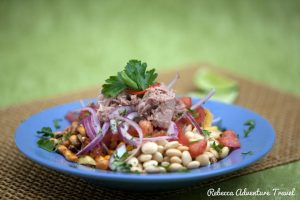
Ceviche de chochos
Ecuadorian Beverages
- Canelazo: A hot beverage commonly made with fruit juices like naranjilla, mora (blackberry), or passion fruit, mixed with cane sugar and water boiled with cinnamon. Sugarcane alcohol is often added, making it a popular choice during events like Fiestas de Quito in December.
- Chicha: A fermented or non-fermented beverage derived from maize, Chicha includes corn beer, like chicha de jora, and non-alcoholic variations such as chica morada. Chichas can also be made from yuca, grapes, apples, or various other fruits. Traditionally, Chicha involved chewing and spitting yuca into the beverage, although this tradition now primarily exists in specific communities and rituals rather than everyday life.
- Morocho: A hearty and sweet drink featuring morocho (dried, cracked corn kernels), milk, cinnamon, sugar, and raisins.
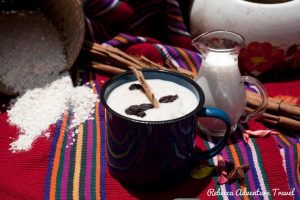
Morocho
- Rompope / Ponche de Leche: A versatile hot or cold beverage enjoyed during holidays, made with milk, sugar, vanilla, egg yolks, condensed milk, cream, and sugarcane alcohol. It can be served with or without alcohol and even transformed into ice cream.
- Guayusa: A holly tree native to the Ecuadorian rainforest, its leaves have energetic, antioxidant, and anti-inflammatory properties. It’s used to make tea and it’s enjoyed hot or cold.
- Colada Morada: A thick, purple drink prepared with typical Ecuadorian fruits and spices, along with purple corn flour. Traditionally consumed in November for Día de los Difuntos (Day of the Dead), it features fruits like naranjilla, pineapple, strawberry, babaco, guava, blackberry, or mortiño (wild blueberry from the Andean paramo). Aromatic herbs and barks, such as cinnamon, cloves, ishpingo, sweet pepper, orange leaf, and luisa grass, are often included.
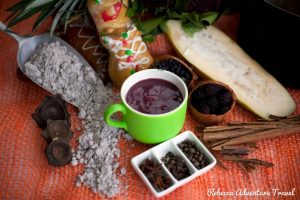
Colada Morada
This Ecuadorian Food Guide accentuates the wide-ranging and diverse gastronomy of Ecuador, shedding light on the country’s abundant culinary heritage even within its compact size. Compose a list of dishes to sample; undoubtedly, you’ll uncover fascinating flavors and sensations that will expand your palate. And, as the saying goes in Ecuador, “Barriga llena, corazón contento!”, meaning “A full belly equals a happy heart!“.
Ecuadorian Culinary Tours
If we’ve captivated your attention and intrigued your senses, exploring the following culinary tours might be an excellent choice for you. Immerse yourself in local culture and learn everything you need to know about the delightful world of Ecuadorian cuisine from the locals themselves. For food enthusiasts in search of new culinary adventures, these tours are precisely what you need. Similarly, if you’re keen on learning how to prepare various Ecuadorian dishes, feel free to get in touch with us to arrange an engaging cooking class in Quito’s Historical Center.
7 Days Galapagos Food Tour Small Group
9 Days Ecuador Food Private Tour
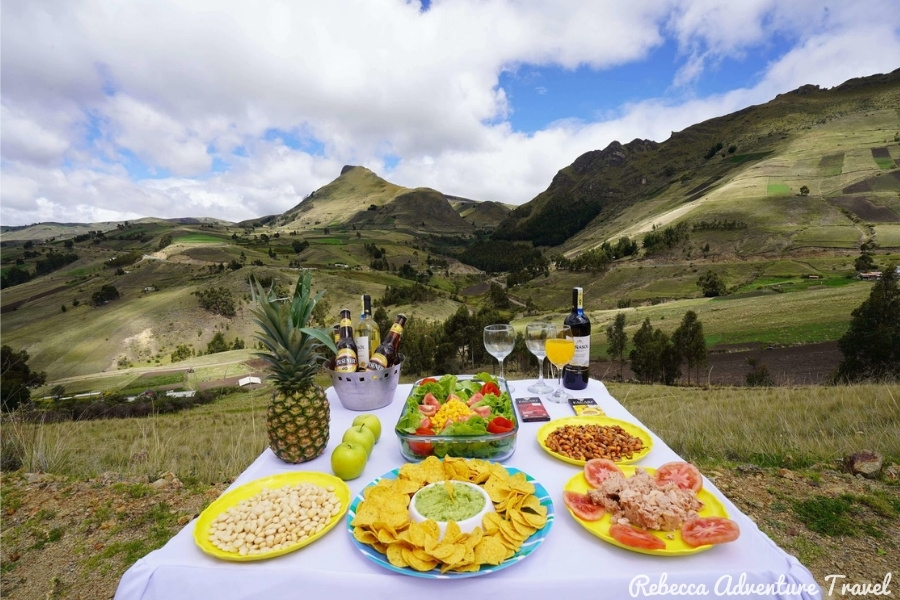
BOOK THE BEST CULINARY EXPERIENCE!
Did you like this post? You might also be interested in:
- The Best Restaurants in the Galapagos Islands
- Top 10 Restaurants in Quito
- Top 5 Family Restaurants Around Quito
*Some images courtesy of the Ecuadorian Ministry of Tourism



